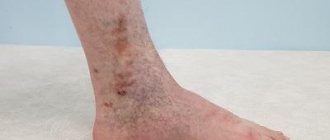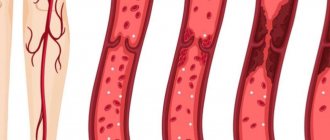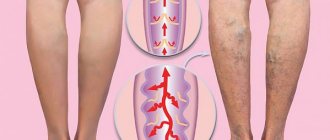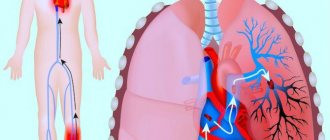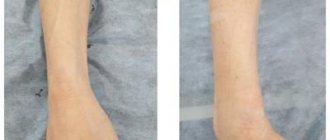Venous diseases often appear due to upright walking. A person must lead an active lifestyle, play sports, and not overload the body with heavy food in order to ensure uninterrupted movement of blood through the veins to the heart. But the outflow of blood can be impaired, due to various reasons. As a result, vein diseases appear.
What is venous stagnation: types of venous hyperemia
Venous hyperemia (or plethora) can be local or generalized. In the first case, the disturbance of blood outflow is localized in one part of the body or a specific organ; in the second, we are talking about changes in blood flow in the entire venous circulatory system. Most often, generalized venous congestion develops against the background of heart disease - coronary artery disease, acute myocardial infarction, heart defects, etc. Based on the speed and intensity of development of the pathological process, acute and chronic forms of venous congestion are distinguished.
The topic of venous hyperemia is quite extensive, so in this article we will talk about one of its forms - venous stagnation in the vessels of the lower extremities.
Chronic venous insufficiency and varicose veins
As the leading cause of chronic venous insufficiency (CVI), varicose veins deserve special attention and consideration. From the standpoint of modern European phlebologists, varicose veins are classified according to the type of blood reflux:
- Vertical reset
- Horizontal reset
In the first case, damage to the valve occurs in the groin area or under the knee, resulting in a downward discharge. The main trunk of the saphenous vein gradually begins to expand due to the constant discharge of blood from veins located deeper. The venous wall is stretched, which leads to damage to the next valve. The described condition is diagnosed as a stem type of varicose veins.
Varicose veins and chronic venous insufficiency
Horizontal discharge is characterized by disruption of the functioning of perforating and communicating veins and their tributaries. European medicine notes the great importance of horizontal discharge for the development of symptoms of chronic venous insufficiency (CVI). However, horizontal reflux develops in most cases later than vertical reflux and indicates the neglect of the pathological process.
Causes and mechanisms of development of venous hyperemia of the legs
Impaired blood flow from the legs to the heart forms the prerequisites for the development of CVI - chronic venous insufficiency. This pathological condition is one of the most common diseases of the cardiovascular system: according to statistics, up to 40% of the adult population in Europe and the USA suffers from chronic venous insufficiency of the lower extremity vessels.
Venous congestion in the elderly
The causes of venous stagnation may be the following:
- Vascular diseases (varicose veins, thrombosis, phlebitis, etc.) Vein diseases are often associated with hyperemia, since in most of them there is a malfunction of the venous valve pump, decreased tone and fragility of blood vessels.
- Sedentary lifestyle and prolonged stay in a fixed body position. If a person spends most of his time sitting or standing, this leads to a slowdown in the blood circulation in the lower extremities. For this reason, it is extremely important to prevent disruption of blood flow in the legs of patients who are lying down.
- Leg injuries. Injuries almost always involve a violation of the integrity of the vascular wall. As it recovers, a blood clot or scar may form at the site of injury, preventing normal blood flow.
- Obesity. Excess weight puts increased pressure on the lower extremities, which impairs blood circulation in them and causes symptoms of venous stagnation.
- Pregnancy. During pregnancy, changes occur in a woman’s body that affect the entire cardiovascular system: there is a decrease in the speed of blood flow in the deep veins of the legs, a decrease in the tone of vascular smooth muscles, and an increase in blood clotting in late pregnancy. In addition, fetal growth can provoke compression of the pelvic veins, which in turn causes a disruption in the outflow of blood from the legs to the heart.
Expert opinion
An increase in body weight during pregnancy, in combination with the above-mentioned prerequisites for the development of CVI, creates favorable conditions for the occurrence of venous stagnation in the lower extremities. During pregnancy, many women note the appearance of telangiectasias (venous “stars”) and varicose veins on their legs. Based on this, expectant mothers are recommended to regularly visit a phlebologist during pregnancy.
Vascular surgeon, phlebologist
Osipova Ekaterina Yakovlevna
- Age-related changes. As the body ages, the condition of the veins may worsen: this is influenced by the presence of concomitant systemic pathologies, a decrease in vascular tone due to menopause, as well as a gradual deterioration in the blood flow of the veins and capillaries. As a result, older people are more likely than younger people to complain of signs of venous stasis.
Varicose veins as one of the causes of chronic venous insufficiency
By the term “chronic venous insufficiency”, modern medical science means a symptom complex associated with impaired venous outflow. Chronic venous insufficiency (CVI) is caused by a number of diseases that lead to disruption of the normal functioning of the venous system, most often of the lower extremities.
The clinical picture of chronic venous insufficiency is very diverse and depends on the stage of the disease.
Symptoms and signs of venous hyperemia
The pathological process manifests itself in the form of swelling, pastiness of soft tissues, changes in the color of the skin, increased vascular patterns, impaired sensitivity, the appearance of cramps, rapid fatigue, a feeling of fullness in the legs; Difficulties appear when walking and performing physical activity.
Ultrasound diagnosis of venous hyperemia
Chronic venous insufficiency. Complications
Disturbances in venous outflow lead to both the extreme degree of chronic venous insufficiency (CVI) - venous trophic ulcers, and thrombosis associated with slow blood flow and chronic inflammation of the venous wall.
Varicose veins and venous insufficiency in the form of ulcers
Medical complications of chronic venous insufficiency not only sharply worsen the quality of life, but also pose a direct threat to it.
How to cure venous congestion in the legs?
Therapy involves relieving the unpleasant symptoms of hyperemia and normalizing blood circulation during venous stagnation. For this, the patient is prescribed decongestants, antispasmodics, anticonvulsants, NSAIDs, phleboprotectors, and anticoagulants. An important role is given to weight normalization, lifestyle correction, and wearing compression stockings. Along with taking medications prescribed by a phlebologist, you can use additional means - for example, Normaven® products. Clinical studies have shown that regular use of the Leg Cream has improved the condition of the veins of the lower extremities in 95.5% of subjects.
Prevention and treatment of venous stagnation in the legs
Diagnosis and treatment of CVI
To avoid serious consequences and cope with the disease in its first stages, you should consult a doctor at the first manifestations of the disease. In Moscow, qualified assistance can be obtained at the First Phlebological Center.
Diagnostics involves a visual examination of the limbs, as well as an ultrasound examination, which gives a complete picture of the condition of the blood vessels. Based on the diagnosis, treatment will be prescribed. It is usually combined and includes:
- compression using special bandages or medical knitwear;
- taking medications that help restore the elasticity of vascular walls;
- the use of ointments and gels that reduce swelling and pain.
Depending on individual characteristics, the doctor may also prescribe diet, swimming, exercise, massage, etc.
Prevention of venous stagnation
- Do as much physical activity as you can.
- Eat right. Nutrition for venous stagnation should include foods rich in fiber, rutin and vitamin C.
- Avoid prolonged static loading.
- Avoid wearing high heels and tight pants.
Sources:
- Sklyarova N.P., Bakhteeva E.R. Organizational aspects of the prevention of postoperative venous thromboembolic complications and pulmonary embolism. // Chief physician of the South of Russia. – 2011. – No. 4 (27). – pp. 25-26.
- Zhane A.K., Zhane Ad. K., Napso H.R., Zhane T.I., Pichugin A.G. Possibilities of diagnosis and treatment of chronic diseases of the veins of the lower extremities. // Kuban Scientific Medical Bulletin. – 2010. – No. 9 (123). – pp. 78-84.
- Safonov L.V. Modern aspects of the prevention of venous circulation disorders of the lower extremities in athletes due to transport physical inactivity. // Bulletin of sports science. – 2009. – P. 36-38.
- Lukyanov V.V., Bondarenko A.V., Bondarenko A.A., Peleganchuk V.A. Disturbances of venous hemodynamics and thromboembolic complications during osteosynthesis of fractures of the lower extremities. // Polytrauma. – 2009. – No. 4. – P.32-28.
- Pisarev V.V., Lvov S.E., Kutyreva O.I., Molchanov O.S. Features of antegrade blood flow and venous thrombotic complications in patients with fractures of the tibia and femur. // Traumatology and orthopedics of Russia. – 2009. – No. 2 (52). – pp. 33-28.
- Bykov A.V., Nazaruk A.S. Selective surgical interventions for varicose veins of the lower extremities. // Bulletin of Volgograd State Medical University. – 2004. – No. 11. – P. 66-68.
For an accurate diagnosis, contact a specialist.
Chronic venous insufficiency. Treatment
The treatment of this disease is based on two basic principles that complement each other, namely: eliminating the symptoms of chronic venous insufficiency and treating the disease that caused it, varicose veins. To eliminate varicose veins, the best solution would be modern methods of endovasal thermoobliteration (laser and radiofrequency).
Treatment of CVI using endovenous thermal methods
Compression therapy and modern venotonics have a good effect against the symptoms of chronic venous insufficiency (CVI). It is an integrated approach to the problem of chronic venous insufficiency that will be its optimal solution.
Residents of Moscow and the Moscow region have a good choice of both phlebology clinics and phlebologists themselves. Artyom Yurievich Semenov, vascular surgeon, head and leading specialist of the Moscow City Phlebology Center, is one of the best experts in the innovative treatment of chronic venous insufficiency (CVI) and varicose veins.
If you contact the city phlebology center, you are guaranteed to be diagnosed according to the best European standards. After modern diagnostics, innovative treatment will be prescribed and carried out as soon as possible.


